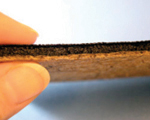25 February 2009
Cutting Interior Trim Panels using Synrad CO2 Lasers
 In the automotive industry, uptime is paramount. The key to increased throughput is to reduce the time required for "make-readys" or equipment changeovers as the production line is reconfigured to produce another component. Whether for trimming fabrics or degating moulded parts, lasers are a key factor-instead of mechanically changing and aligning an entire die, the laser's motion controller is simply reprogrammed by loading the appropriate cutting file. The laser's ability to make precision cuts piece after piece allows you to lay out cutting files to minimise waste and produce the maximum number of pieces per unit of material. The laser's fine power control means that output power can ramp down proportionally in the event that one or more motion axes slows down while executing a tight contour.
In the automotive industry, uptime is paramount. The key to increased throughput is to reduce the time required for "make-readys" or equipment changeovers as the production line is reconfigured to produce another component. Whether for trimming fabrics or degating moulded parts, lasers are a key factor-instead of mechanically changing and aligning an entire die, the laser's motion controller is simply reprogrammed by loading the appropriate cutting file. The laser's ability to make precision cuts piece after piece allows you to lay out cutting files to minimise waste and produce the maximum number of pieces per unit of material. The laser's fine power control means that output power can ramp down proportionally in the event that one or more motion axes slows down while executing a tight contour.
This example shows laser cutting of a 5.3 mm (0.210") thick automotive interior panel consisting of a 0.5 mm (0.020") thick woven fabric that was stretched over 2.8 mm (0.110") foam padding and glued to a 2 mm (0.080") fibre board backing. As the photo shows, the laser-cut fabric edge is clean and sealed, which eliminates fraying, while the fibreboard backing exhibits very light charring. Because of its lower melting point, the central foam padding is undercut by approximately 0.5 mm (0.20”) and the outer edge is melted, however this melting extends only 0.025 mm to 0.050 mm (0.001” to 0.002”) into the foam and does not affect its resiliency.
- Contact Information
- Name: Gary Broadhead
- Email: garyb@laserlines.co.uk

